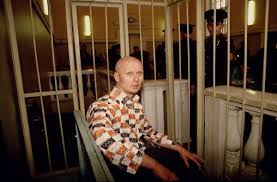
Andrei Chikatilo was a former school teacher who murdered more than 50 young people in the Soviet Union. Andrei Chikatilo was born on October 16, 1936, in the Ukraine state of the USSR. Chikatilo had a difficult childhood and the only sexual experience as an adolescent ended quickly and led to much ridicule, leading to later sexually violent acts. When the police caught him, he confessed to the gruesome murder of 56 and was found guilty in 1990 and executed in 1994. He was born on October 16, 1936, in Yablochnoye, a village in the heart of rural Ukraine in the USSR. During the 1930s, Ukraine was known as the "Breadbasket" of the Soviet Union. Stalin's policies of agricultural collectivization caused widespread hardship and famine that decimated the population. At the time of Chikatilo's birth, the effects of the famine were still widely felt, and his early childhood was influenced by deprivation. The situation was made worse still when the USSR entered World War II against Germany, bringing sustained bombing raids on Ukraine.
In addition to the external hardships, Chikatilo is believed to have suffered from hydrocephalus (water on the brain) at birth, which caused him genital-urinary tract problems later in life, including bed-wetting into his late adolescence and, later, the inability to sustain an erection, although he was able to ejaculate. His home life was disrupted by his father's conscription into the war against Germany, where he was captured, held prisoner, and then vilified by his countrymen for allowing himself to be captured, when he finally returned home. Chikatilo suffered the consequences of his father's "cowardice", making him the focus of school bullying. Painfully shy as a result of this, his only sexual experience during adolescence occurred, aged 15, when he is reported to have overpowered a young girl, ejaculating immediately during the brief struggle, for which he received even more ridicule. This humiliation colored all future sexual experiences, and cemented his association of sex with violence.
He failed his entrance exam to Moscow State University, and a spell of National Service was followed by a move to Rodionovo-Nesvetayevsky, a town near Rostov, in 1960, where he became a telephone engineer. His younger sister moved in with him and, concerned by his lack of success with the opposite sex, she engineered a meeting with a local girl, Fayina, whom he went on to marry in 1963. Despite his sexual problems, and lack of interest in conventional sex, they produced two children, and lived an outwardly normal family life. In 1971 Chikatilo changed careers to become a schoolteacher. A string of complaints about indecent assaults on young children forced him to move from school to school, before he finally settled at a mining school in Shakhty, near Rostov. An eyewitness had seen Chikatilo with the victim, shortly before her disappearance, but his wife provided him with an iron-clad alibi that enabled him to evade any further police attention. Alexsandr Kravchenko, a 25-year-old with a previous rape conviction, was arrested and confessed to the crime under duress, probably as a result of extensive and brutal interrogation. He was tried for the killing of Lena Zakotnova, and executed in 1984.
Perhaps as a result of his close brush with the law, there were no more documented victims for the next three years. Still dogged by claims of child abuse, Chikatilo found it impossible to find another teaching post, when he was made redundant from his mining school post, in early 1981. He took a job as a clerk for a raw materials factory in Rostov, where the travel involved with the position gave him unlimited access to a wide range of young victims over the next nine years. Larisa Tkachenko, 17, became his next victim. On September 3, 1981, Chikatilo strangled, stabbed and gagged her with earth and leaves to prevent her crying out. The brutal force afforded Chikatilo his sexual release, and he began to develop a pattern of attack that saw him focusing on young runaways of both sexes. He befriended them at train stations and bus stops, before luring them into nearby forest areas, where he would attack them, attempt rape and use his knife, to mutilate them. In a number of cases he ate the sexual organs, or removed other body parts such as the tips of their noses or tongues. In the earliest cases, the common pattern was to inflict damage to the eye area, slashing across the sockets and removing the eyeballs in many cases, an act which Chikatilo later attributed to a belief that his victims kept an imprint of his face in their eyes, even after death.
At this time serial killers were a virtually unknown phenomenon in the Soviet Union. Evidence of serial killing, or child abuse, was sometimes suppressed by state-controlled media, in the interests of public order. The eye mutilation was a modus operandi distinct enough to allow for other cases to be linked, when the Soviet authorities finally admitted that they had a serial killer to contend with. As the body count mounted, rumors of foreign inspired plots, and werewolf attacks, became more prevalent, and public fear and interest grew, despite the lack of any media coverage. In 1983 Moscow detective Major Mikhail Fetisov assumed control of the investigation. He recognized that a serial killer might be on the loose, and assigned a specialist forensic analyst, Victor Burakov, to head the investigation in the Shakhty area. The investigation centered on known sex offenders, and the mentally ill, but such were the interrogation methods of the local police that they regularly solicited false confessions from prisoners, leaving Burakov skeptical of the majority of these "confessions". Progress was slow, especially as, at that stage, not all of the victim's bodies had been discovered, so the true body count was unknown to the police. With each body, the forensic evidence mounted, and police were convinced that the killer had the blood type AB, as evidenced by the semen samples collected from a number of crime scenes. Samples of identical grey hair were also retrieved.
When a further 15 victims were added during the course of 1984, police efforts were increased drastically, and they mounted massive surveillance operations that canvassed most local transport hubs. Chikatilo was arrested for behaving suspiciously at a bus station at this time, but again avoided suspicion on the murder charges, as his blood type did not match the suspect profile, but he was imprisoned for three months for a number of minor outstanding offenses. What was not realized at the time was that Chikatilo's actual blood type, type A, was different to the type found in his other bodily fluids (type AB), as he was a member of a minority group known as "non-secretors", whose blood type cannot be inferred by anything other than a blood sample. As police only had a sample of semen, and not blood, from the crime scenes, Chikatilo was able to escape suspicion of murder. Today's sophisticated DNA techniques are not subject to the same fallibility.
Following his release, Chikatilo found work as a traveling buyer for a train company, based in Novocherkassk, and managed to keep a low profile until August 1985, when he murdered two women in separate incidents. At around the same time as these murders, Burakov, frustrated at the lack of positive progress, engaged the help of psychiatrist, Alexandr Bukhanovsky, who refined the profile of the killer. Bukhanovsky described the killer as a "necro-sadist", or someone who achieves sexual gratification from the suffering and death of others. Bukhanovsky also placed the killer's age as between 45 and 50, significantly older than had been believed up to that point. Desperate to catch the killer, Burakov even interviewed a serial killer, Anatoly Slivko, shortly before his execution, in an attempt to gain some insight into his elusive serial killer.
Coinciding with this attempt to understand the mind of the killer, attacks seemed to dry up, and police suspected that their target might have stopped killing, been incarcerated for other crimes, or died. However, early in 1988, Chikatilo again resumed his killing, the majority occurring away from the Rostov area, and victims were no longer taken from local public transport outlets, as police surveillance of these areas continued. Over the next two years the body count increased by a further 19 victims, and it appeared that the killer was taking increasing risks, focusing primarily on young boys, and often killing in public places where the risk of detection was far higher.



























Recommended Comments
There are no comments to display.
Join the conversation
You can post now and register later. If you have an account, sign in now to post with your account.